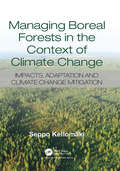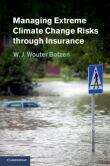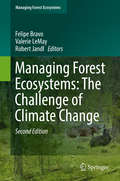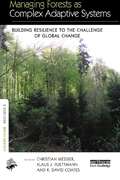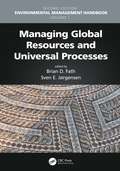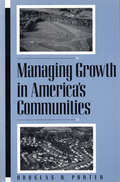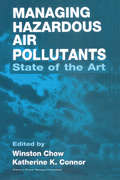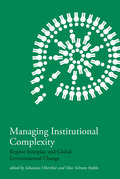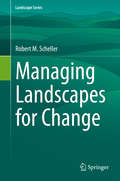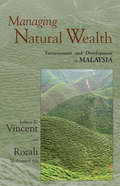- Table View
- List View
Managing Boreal Forests in the Context of Climate Change: Impacts, Adaptation and Climate Change Mitigation
by Seppo KellomakiIn many places in the world, forests dominate landscapes and provide various products. Future climate change could profoundly alter the productivity of forest ecosystems and species composition. Until now, climate impact research has primarily focused on the likely impacts of rise in temperature, increased atmospheric CO2 concentration, and varying precipitation on unmanaged forests. The issue that now needs to be addressed is how to sustainably manage climate change for timber production and biomass. Though climate change is a global issue, impacts on forests depend on local environmental conditions and management methods, so this book will look at the issue under varying local contexts.
Managing Climate Change Business Risks and Consequences: Leadership for Global Sustainability
by Charles Wankel James A. F. Stoner Neil Washington Matt Marovich Kyle MillerAlthough the title of this volume and its major focus will be on one major aspect of global sustainability - climate change - this volume continues with the overall framing of the series: global sustainability is a multi-faceted, global, multi-generational, economic, social, environmental, and cultural phenomenon and challenge to our species.
Managing Coal Combustion Residues In Mines
by National Research Council of the National AcademiesBurning coal in electric utility plants produces, in addition to power, residues that contain constituents which may be harmful to the environment. The management of large volumes of coal combustion residues (CCRs) is a challenge for utilities, because they must either place the CCRs in landfills, surface impoundments, or mines, or find alternative uses for the material. This study focuses on the placement of CCRs in active and abandoned coal mines. The committee believes that placement of CCRs in mines as part of the reclamation process may be a viable option for the disposal of this material as long as the placement is properly planned and carried out in a manner that avoids significant adverse environmental and health impacts. This report discusses a variety of steps that are involved in planning and managing the use of CCRs as minefills, including an integrated process of CCR characterization and site characterization, management and engineering design of placement activities, and design and implementation of monitoring to reduce the risk of contamination moving from the mine site to the ambient environment. Enforceable federal standards are needed for the disposal of CCRs in minefills to ensure that states have adequate, explicit authority and that they implement minimum safeguards.
Managing Coastal and Inland Waters
by Arif Satria Kenneth RuddleBesides the erroneous assumption that tropical fisheries are 'open access', the cases demonstrate that pre-existing systems (1) are concerned with the community of fishers and ensuring community harmony and continuity; (2) involve flexible, multiple and overlapping rights adapted to changing needs and circumstances; (3) that fisheries are just one component of a community resource assemblage and depend on both the good management of linked upstream ecosystems and risk management to ensure balanced nutritional resources of the community; and (4) pre-existing systems are greatly affected by a constellation of interacting external pressures.
Managing Energy, Nutrients, and Pests in Organic Field Crops (Integrative Studies in Water Management & Land Development)
by Ralph C. Martin Rod MacRaeThe use of organic management practices in field cropping continues to rise globally, and these methods have proven to be a viable way to produce food with reduced resource use and environmental damage. Managing Energy, Nutrients, and Pests in Organic Field Crops challenges the popular misconception that organic systems are weak at managing energy,
Managing Environmental Conflict: An Earth Institute Sustainability Primer (Columbia University Earth Institute Sustainability Primers)
by Joshua D. FisherConflicts frequently arise over environmental issues such as land use, natural resource management, and laws and regulation, emerging from diverging interests and values among stakeholders. This book is a primer on causes of and solutions to such conflicts. It provides a foundational overview of the theory and practice of collaborative approaches to managing environmental disputes.Joshua D. Fisher explains the core concepts in collaborative conflict management and presents a clear, practical, and implementable framework for understanding and responding to environmental disputes. He details strategies to bring stakeholders together in pursuit of collective solutions, emphasizing ongoing processes of dialogue, analysis, action, and learning. This collaborative approach can create new opportunities for stakeholders to better understand each other and the natural world, which enables more effective and context-appropriate environmental governance. The primer examines why and how system dynamics can constrain or expand the possibility of constructive management of conflicts. It features a case study from the Amazon Basin, where local communities, extractive industry operators, conservationists, and land managers have often clashed over access to natural resources, drawing out lessons to illustrate how to adapt the conflict management framework to distinct contexts.Managing Environmental Conflict synthesizes knowledge, methods, and practices spanning consensus building, collaborative governance, complex adaptive systems science, environmental conflict resolution, and environmental peacebuilding. Its presentation of this important and timely topic will be invaluable for academics and practitioners alike, including decision makers, scientists, and conflict management professionals.
Managing Environmental Risks through Insurance: Legal and Economic Aspects (AIDA Europe Research Series on Insurance Law and Regulation #9)
by Katarzyna Malinowska Dorota MaśniakThis book identifies the role of insurance in a comprehensive system for managing environmental risks at the local, regional and global level. National and international legal instruments regulating environmental protection, especially aspects like pollution, are not precisely reflected in insurance concepts intended to cover environmental risks. As such, there is a need to identify environmental risks and to propose a taxonomy of environmental risks for various types of insurance coverage. The authors refer to the issues of liability in environmental protection, the scope of insurance coverage and comment on specific issues the importance of which has been noticed by the legislator or insurance practice. The book examines these issues horizontally and vertically from various standpoints, focusing on insurance as a means of managing environmental risks. In this regard, it mainly concentrates on (1) identifying and analyzing environmental risks and methods for managing them via private and public instruments, and (2) insuring these risks. The book is intended for all those interested in the field of insurance and environmental risk regimes, including lawyers, academics and legal professionals.
Managing Extreme Climate Change Risks through Insurance
by W. J. Wouter BotzenIn recent years, the damage caused by natural disasters has increased worldwide; this trend will only continue with the impact of climate change. Despite this, the role for the most common mechanism for managing risk - insurance - has received little attention. This book considers the contribution that insurance arrangements can make to society's management of the risks of natural hazards in a changing climate. It also looks at the potential impacts of climate change on the insurance sector, and insurers' responses to climate change. The author combines theory with evidence from the rich experiences of the Netherlands together with examples from around the world. He recognises the role of the individual in preparing for disasters, as well as the difficulties individuals have in understanding and dealing with infrequent risks. Written in plain language, this book will appeal to researchers and policy-makers alike.
Managing Forest Carbon in a Changing Climate
by Mark S. Ashton Mary L. Tyrrell Bradford Gentry Deborah SpaldingThe aim of this book is to provide an accessible overview for advanced students, resource professionals such as land managers, and policy makers to acquaint themselves with the established science, management practices and policies that facilitate sequestration and allow for the storage of carbon in forests. The book has value to the reader to better understand: a) carbon science and management of forests and wood products; b) the underlying social mechanisms of deforestation; and c) the policy options in order to formulate a cohesive strategy for implementing forest carbon projects and ultimately reducing emissions from forest land use.
Managing Forest Ecosystems: The Challenge of Climate Change
by Robert Jandl Felipe Bravo Valerie LemayClimate change shaped the political agenda during the last decade with three issues as hot topics: commonly making the headlines: carbon budgets, impact and mitigation of climate change. Given the significant role that forests play in the climate system - as sources, sinks, and through carbon trading - this book update the current scientific evidences on the relationships between climate, forest resources and forest management practices around the world. By including the forest scientists' expertise from around the world, the book presents and updates a depth analysis of the current knowledge, and a series of case studies focused on the biological and the economic impacts of climate change in forest ecosystems in Africa, Asia, Europe and North and South America. The book will form a valuable resource for researchers and advanced students dealing with sustainable forestry, climate change issues and the effects of climate change on natural resource management.
Managing Forests as Complex Adaptive Systems: Building Resilience to the Challenge of Global Change (The Earthscan Forest Library)
by Christian Messier K. David Coates Klaus J. PuettmannThis book links the emerging concepts of complexity, complex adaptive system (CAS) and resilience to forest ecology and management. It explores how these concepts can be applied in various forest biomes of the world with their different ecological, economic and social settings, and history. Individual chapters stress different elements of these concepts based on the specific setting and expertise of the authors. Regions and authors have been selected to cover a diversity of viewpoints and emphases, from silviculture and natural forests to forest restoration, and from boreal to tropical forests. The chapters show that there is no single generally applicable approach to forest management that applies to all settings. The first set of chapters provides a global overview of how complexity, CAS and resilience theory can benefit researchers who study forest ecosystems. A second set of chapters provides guidance for managers in understanding how these concepts can help them to facilitate forest ecosystem change and renewal (adapt or self-organize) in the face of global change while still delivering the goods and services desired by humans. The book takes a broad approach by covering a variety of forest biomes and the full range of management goals from timber production to forest restoration to promote the maintenance of biodiversity, quality of water, or carbon storage.
Managing Geo-Based Challenges
by Serwan M. J. BabanThis book provides sound conceptual understanding of the current approach to management and decision making regarding geo-based challenges in developing countries that tend to suffer from information poverty and subjectivity and are reactive. The book also provides the necessary technical tools to energize research thinking and develop locally driven practical and sustainable solutions, ultimately moving management and decision making from being reactive to being proactive. This book fills a void as there are no published books to show the way forward or to present real case studies for this purpose. Case studies that utilize new technologies and scientific thinking are presented for developing sustainable management options based either on producing local applied research or on utilising relevant international research. These case studies are based on the author's first-hand experiences in arid/semi-arid (Iraq, Tunisia, Morocco and Jordan), temperate (UK) and tropical environments (Malaysia, the Caribbean region, Indonesia and Australia).
Managing Geographic Information Systems, Second Edition
by Jeffrey Pinto Nancy ObermeyerNow in a fully revised and expanded second edition, this widely adopted text and practical reference addresses all aspects of developing and using geographic information systems (GIS) within an organization. Coverage includes the role of the GIS professional, how geographic information fits into broader management information systems, the use of GIS in strategic planning, and ways to navigate the organizational processes that support or inhibit the success of GIS implementation. All chapters retained from the prior edition have been thoroughly updated to reflect significant technological, empirical, and conceptual advances, as well as the changing contexts of GIS use. New chapters discuss organizational politics, metadata, legal issues, and GIS ethics.
Managing Global Resources and Universal Processes (Routledge Studies in Environmental Migration, Displacement and Resettlement)
by Brian D. Fath Megan Cole Sven E. JørgensenBringing together a wealth of knowledge, Environmental Management Handbook, Second Edition, gives a comprehensive overview of environmental problems, their sources, their assessment, and their solutions. Through in-depth entries and a topical table of contents, readers will quickly find answers to questions about environmental problems and their corresponding management issues. This six-volume set is a reimagining of the award-winning Encyclopedia of Environmental Management, published in 2013, and features insights from more than 500 contributors, all experts in their field. The experience, evidence, methods, and models used in studying environmental management are presented here in six stand-alone volumes, arranged along the major environmental systems. Features The first handbook that demonstrates the key processes and provisions for enhancing environmental management Addresses new and cutting-edge topics on ecosystem services, resilience, sustainability, food–energy–water nexus, socio-ecological systems, and more Provides an excellent basic knowledge on environmental systems, explains how these systems function, and offers strategies on how to best manage them Includes the most important problems and solutions facing environmental management today In this first volume, Managing Global Resources and Universal Processes, the reader is introduced to the general concepts and processes used in environmental management. As an excellent resource for finding basic knowledge on environmental systems, it reflects an extensive coverage of the field and includes the most important problems and solutions facing environmental management today. This book practically demonstrates the key processes, methods, and models used in studying environmental management.
Managing Growth in America's Communities: Second Edition
by Douglas R. PorterCommunities across the country are turning to the concept of "growth management" to help plan for the future, as they seek to control the location, impact, character and timing of development in order to balance environmental and economic needs and concerns. Managing Growth in America's Communities presents practical information about proven strategies, programs and techniques of growth management for urban and rural communities. Topics examined include: public roles in community development determining locations and character of future development protecting environmental and natural resources managing infrastructure development preserving community character and quality achieving economic and social goals property rights concerns The author describes regulatory and programmatic techniques that have been most useful, obstacles to be overcome, and specific strategies that have been instrumental in achieving successful growth management programs. He provides examples from dozens of communities across the country as well as state and regional approaches currently in use. Brief profiles present overviews of problems addressed, techniques implemented, outcomes, and contact information for conducting further research. Among the communities profiled are Arlington County, Virginia; Fort Collins, Colorado; Lexington-Fayette County, Kentucky; Lincoln, Nebraska; Sarasota, Florida; Raleigh, North Carolina; Scottsdale, Arizona; and numerous others. Also included in the volume are informational sidebars written by leading experts in growth management including Robert Yaro, John De Grove, David Brower, and others.Managing Growth in America's Communities is essential reading for community development specialists including government officials, planners, environmentalists, designers, developers, business people, and concerned citizens seeking innovative and feasible ways to manage growth.
Managing Growth in America's Communities: Second Edition
by Douglas R. PorterIn this thoroughly revised edition of Managing Growth in America's Communities, readers will learn the principles that guide intelligent planning for communities of any size, grasp the major issues in successfully managing growth, and discover what has actually worked in practice (and where and why). This clearly written book details how American communities have grappled with the challenges of planning for growth and the ways in which they are adapting new ideas about urban design, green building, and conservation. It describes the policies and programs they have implemented, and includes examples from towns and cities throughout the U.S.Growth management is essential today, as communities seek to control the location, impact, character, and timing of development in order to balance environmental and economic needs and concerns.The author, who is one of the nation's leading authorities on managing community growth, provides examples from dozens of communities across the country, as well as state and regional approaches. Brief profiles present overviews of specific problems addressed, techniques utilized, results achieved, and contact information for further research. Informative sidebars offer additional perspectives from experts in growth management, including Robert Lang, Arthur C. Nelson, Erik Meyers, and others.In particular, he considers issues of population growth, eminent domain, and the importance of design, especially green design. He also reports on the latest ideas in sustainable development, smart growth, neighborhood design, transit-oriented development, and green infrastructure planning. Like its predecessor, the second edition of Managing Growth in America's Communities is essential reading for anyone who is interested in how communities can grow intelligently.
Managing Hazardous Air Pollutants: State of the Art
by Winston Chow Katherine ConnorManaging Hazardous Air Pollutants presents a detailed examination of the state-of-the-art in the management of air pollutants ("air toxics"). This important new volume focuses on the latest research, regulatory perspectives, modeling, environmental and human risk assessments, new control strategies, monitoring programs, risk communication, and risk management. Key chapters in the book are devoted to these timely subjects:
Managing Human and Social Systems
by Brian D. Fath Sven E. JørgensenBringing together a wealth of knowledge, Environmental Management Handbook, Second Edition, gives a comprehensive overview of environmental problems, their sources, their assessment, and their solutions. Through in-depth entries and a topical table of contents, readers will quickly find answers to questions about environmental problems and their corresponding management issues. This six-volume set is a reimagining of the award-winning Encyclopedia of Environmental Management, published in 2013, and features insights from more than 400 contributors, all experts in their field. The experience, evidence, methods, and models used in studying environmental management are presented here in six stand-alone volumes, arranged along the major environmental systems. Features The first handbook that demonstrates the key processes and provisions for enhancing environmental management Addresses new and cutting-edge topics on ecosystem services, resilience, sustainability, food–energy–water nexus, socio-ecological systems, and more Provides an excellent basic knowledge on environmental systems, explains how these systems function, and offers strategies on how to best manage them Includes the most important problems and solutions facing environmental management today In this sixth volume, Managing Human and Social Systems, the reader is introduced to the general concepts and processes of all the environmental tools and their application to human and social systems. It explains how these systems function and provides strategies on how to best manage them. It serves as an excellent resource for finding basic knowledge on the human and social systems and includes important problems and solutions that environmental managers face today. This book practically demonstrates the key processes, methods, and models used in studying environmental management.
Managing Hurricane Katrina: Lessons from a Megacrisis
by Arjen Boin Christer Brown Professor James A. RichardsonThe government’s response to Hurricane Katrina, one of the most devastating natural disasters in U.S. history, suffered numerous criticisms. Nearly every assessment pointed to failure, from evaluations of President George W. Bush, FEMA, and the Department of Homeland Security to the state of Louisiana and the city administration of New Orleans. In Managing Hurricane Katrina: Lessons from a Megacrisis, Arjen Boin, Christer Brown, and James A. Richardson deliver a more nuanced examination of the storm’s aftermath than the ones anchored in public memory, and identify aspects of management that offer more positive examples of leadership than bureaucratic and media reports indicated. Katrina may be the most extensively studied disaster to date, but the authors argue that many academic conclusions are inaccurate or contradictory when examined in concert. Drawing on insights from crisis and disaster management studies, Boin, Brown, and Richardson apply a clear framework to objectively analyze the actions of various officials and organizations during and after Katrina. They specify critical factors that determine the successes and failures of a societal response to catastrophes and demonstrate how to utilize their framework in future superdisasters. Going beyond previous assessments, Managing Hurricane Katrina reconsiders the role of government in both preparing for a megacrisis and building an effective response network at a time when citizens need it most.
Managing Institutional Complexity
by Sebastian Oberthür Olav Schram StokkeInstitutional interaction and complexity are crucial to environmental governance and are quickly becoming dominant themes in the international relations and environmental politics literatures. This book examines international institutional interplay and its consequences, focusing on two important issues: how states and other actors can manage institutional interaction to improve synergy and avoid disruption; and what forces drive the emergence and evolution of institutional complexes, sets of institutions that cogovern particular issue areas. The book, a product of the Institutional Dimensions of Global Environmental Change research project (IDGEC), offers both theoretical and empirical perspectives. Chapters range from analytical overviews to case studies of institutional interaction, interplay management, and regime complexes in areas including climate change, fisheries management, and conservation of biodiversity. Contributors discuss such issues as the complicated management of fragmented multilateral institutions addressing climate change; the possible "chilling effect" on environmental standards from existing commitments; governance niches in Arctic resource protection; the relationships among treaties on conservation and use of plant genetic resources; causal factors in cross-case variation of regime prevalence; and the difficult relationship between the World Trade Organization and multilateral environmental agreements. The book offers a broad overview of research on interplay management and institutional complexes that provides important insights across the field of global environmental governance.
Managing Institutional Complexity: Regime Interplay and Global Environmental Change
by Sebastian Oberthür Olav Schram StokkeExperts investigate how states and other actors can improve inter-institutional synergy and examine the complexity of overlapping environmental governance structures.Institutional interaction and complexity are crucial to environmental governance and are quickly becoming dominant themes in the international relations and environmental politics literatures. This book examines international institutional interplay and its consequences, focusing on two important issues: how states and other actors can manage institutional interaction to improve synergy and avoid disruption; and what forces drive the emergence and evolution of institutional complexes, sets of institutions that cogovern particular issue areas.The book, a product of the Institutional Dimensions of Global Environmental Change research project (IDGEC), offers both theoretical and empirical perspectives. Chapters range from analytical overviews to case studies of institutional interaction, interplay management, and regime complexes in areas including climate change, fisheries management, and conservation of biodiversity. Contributors discuss such issues as the complicated management of fragmented multilateral institutions addressing climate change; the possible “chilling effect” on environmental standards from existing commitments; governance niches in Arctic resource protection; the relationships among treaties on conservation and use of plant genetic resources; causal factors in cross-case variation of regime prevalence; and the difficult relationship between the World Trade Organization and multilateral environmental agreements. The book offers a broad overview of research on interplay management and institutional complexes that provides important insights across the field of global environmental governance.
Managing Land Use Conflicts: Case Studies in Special Area Management
by David J. Brower Daniel S. CarolThis work contains a series of case studies of the planning phenomenon that has become known as Special Area Management (SAM)--those areas so naturally valuable, so important for human use, so sensitive to impact, or so particular in their planning requirements as to need special management treatment. Based on an examination of the SAMs, this work integrates various aspects of the process of their planning and management and proposes policy and administrative guidelines to improve SAMs as a planning tool.
Managing Landscapes for Change (Landscape Series #27)
by Robert M. SchellerThis book discusses how future landscapes will be shaped by pervasive change and where, when, and how society should manage landscapes for change. Readers will learn about the major anthropogenic drivers of landscape change, including climate change and human induced disturbance regimes, and the unique consequences that multiple and simultaneously occurring change agents can have on landscapes. The author uses landscape trajectories as a guide to selecting the appropriate course of action, and considers how landscape position, inertia, and direction will determine landscape futures. The author introduces the concept of landscapes as socio-technical-ecological systems (STES), which combines ecological and technological influences on future landscape change and the need for society to acknowledge both when considering landscape management. Thinking beyond solutions, the author identifies barriers to managing landscapes for change including the cost, cultural identity of local populations, and the fear of taking action under uncertain conditions. Nevertheless, processes, tools, and technologies exist for overcoming social and ecological barriers to managing landscapes for change, and continued investment in social and scientific infrastructure holds out hope for maintaining our landscape values even as we enter an era of unprecedented change and disruption.
Managing Natural Wealth: Environment and Development in Malaysia
by Jeffrey R. Vincent Rozali Professor Mohamed AliThe remarkably rich natural environment of Malaysia attracts the interest of both industry and the environmental community. Managing Natural Wealth analyzes major natural resource and environmental policy issues in the country during the 1970s and 1980s-a period of profound socioeconomic change, rapid depletion of natural resources, and the emergence of serious problems with pollution. Managing Natural Wealth is an important up-date to Environment and Development in a Resource-Rich Economy: Malaysia under the New Economic Policy. First published in hardcover in 1997, this pathbreaking book emphasized economics as a source for analyzing the issues involved in environmental and natural resource management in developing countries. The access that Jeffrey Vincent and Rozali Mohamed Ali and the contributing authors had to unpublished data and key decisionmakers made their account an essential reference for policymakers and researchers in Malaysia and throughout the globe. Managing Natural Wealth includes a review of key developments since the 1990s by S. Robert Aiken and Colin H. Leigh, two geographers with a long-standing interest in environmental change in Malaysia and an understanding of the institutional context of its environmental policy that is unmatched in the scholarly community.
Managing Northern Europe's Forests: Histories from the Age of Improvement to the Age of Ecology (Environment in History: International Perspectives #12)
by K. Jan Oosthoek Richard HölzlNorthern Europe was, by many accounts, the birthplace of much of modern forestry practice, and for hundreds of years the region’s woodlands have played an outsize role in international relations, economic growth, and the development of national identity. Across eleven chapters, the contributors to this volume survey the histories of state forestry policy in Scandinavia, the Low Countries, Germany, Poland, and Great Britain from the early modern period to the present. Each explores the complex interrelationships of state-building, resource management, knowledge transfer, and trade over a period characterized by ongoing modernization and evolving environmental awareness.
